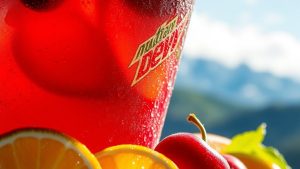
To distinguish real blue raspberry flavor from artificial, recognize that true blue raspberries don't exist in nature. The artificial flavor is a synthetic creation crafted from esters mimicking fruity notes like cherry and banana. Unlike the slightly tart taste of the white bark raspberry, blue raspberry flavor lacks a specific raspberry ester, making it distinctly different. Its vibrant blue hue is enhanced by artificial dye, so when you encounter blue raspberry, remember it's primarily a manufactured experience. Explore further for more intriguing details on this unique flavor!
Have you ever wondered why blue raspberry flavor is so distinct yet doesn't come from any actual blue raspberries? It's a fascinating topic that bridges the gap between nature and artificial flavor creation. When you think about blue raspberries, you might conjure images of vibrant candies or icy treats, but in reality, blue raspberries don't exist in nature. The closest relative, the white bark raspberry (*Rubus leucodermis*), has a dark purple to blue-purple hue, yet its flavor profile is markedly different, offering a slightly tart taste that diverges from the sweetness you associate with traditional raspberries.
The flavor you recognize as blue raspberry is entirely synthetic. It's crafted from an intricate combination of esters, which are chemical compounds that contribute to the fruity taste. Specifically, cherry, banana, and pineapple esters unite to create the flavor sensation you find in various products. This unique blend diverges considerably from any real fruit, allowing the flavor to stand out, particularly in a market where red flavors like cherry and strawberry dominate.
The vibrant blue color enhances its appeal and sets it apart, largely thanks to artificial food dyes like Blue No. 1, which not only provide a striking visual cue but also play an essential role in marketing strategies aimed at children. Blue No. 1 food dye was intentionally chosen to create a contrasting visual effect with other flavors, particularly red ones.
Historically, the introduction of blue raspberry flavor began in the 1970s with ICEEs. This innovative move helped shift consumer expectations and preferences, especially as there were growing safety concerns about certain red dyes. The allure of a bright blue flavor not only captured attention but also created a psychological appeal; bright colors tend to attract younger consumers, bolstering blue raspberry's popularity.
When examining the chemical composition of blue raspberry flavor, you'll find that it doesn't rely on any specific raspberry ester, as none exists. Instead, manufacturers create a harmonious blend of flavor compounds that mimic the taste experience without the nutritional benefits typically associated with real fruits. The aroma is also considerable; it enhances your perception of flavor, making the experience more enjoyable and memorable.
Despite its widespread use, few realize the real inspiration behind blue raspberry flavor. The rarity of the white bark raspberry means that most consumers are unfamiliar with its existence. Instead, they associate the flavor with fun, indulgent experiences like enjoying an ICEE on a hot day or savoring a blue raspberry candy.
The flavor's popularity remains high, especially among children, who are drawn to the eye-catching color and sweet taste.
Conclusion
In the world of flavors, can you really tell the difference between genuine blue raspberry and its artificial counterpart? By focusing on the nuanced balance of tartness, sweetness, and a hint of earthiness, you can sharpen your palate. Real blue raspberry flavor often carries a complexity that artificial versions lack, leaving a lingering, authentic taste. Engaging in this flavor journey not only enhances your culinary experiences but also deepens your appreciation for the intricacies of taste.



